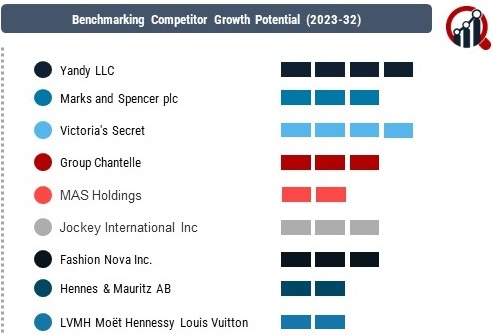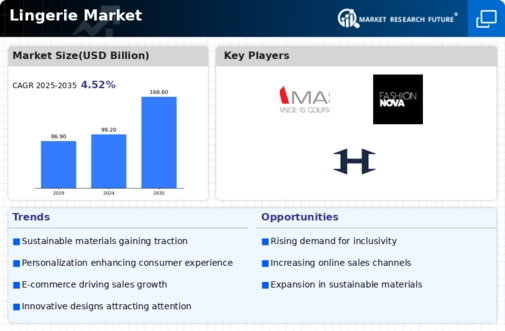Top Industry Leaders in the Lingerie Market

One of the primary strategies adopted by leading companies involves continuous product innovation and diversification. Victoria's Secret, for instance, has been at the forefront of introducing new designs and collections, staying attuned to changing consumer preferences. Calvin Klein has focused on premium offerings and collaborations to enhance its brand appeal. Additionally, strategic partnerships with influencers and celebrities have become a common tactic to create buzz and widen consumer reach.
Market share analysis in the lingerie industry hinges on several factors, including brand reputation, product quality, pricing, and distribution channels. Established brands with a longstanding reputation often enjoy a loyal customer base, which contributes significantly to their market share. Product quality, reflecting comfort, durability, and design aesthetics, is a crucial determinant of consumer preferences. Competitive pricing strategies, coupled with effective distribution channels, enable companies to reach diverse consumer segments and maintain a competitive edge.
While industry giants dominate the market, new and emerging companies have also entered the arena, introducing fresh perspectives and innovative approaches. Start-ups such as ThirdLove and Adore Me have disrupted the traditional lingerie market by emphasizing inclusivity, diverse sizing, and direct-to-consumer models. These newcomers leverage e-commerce platforms and digital marketing strategies to connect with consumers directly, challenging the market dominance of established players.
The lingerie market has witnessed notable industry news, including acquisitions and strategic alliances. Mergers and acquisitions have been a prevalent trend among key players aiming to strengthen their market positions and diversify their product offerings. Additionally, collaborations between lingerie brands and fashion designers have gained traction, enabling companies to tap into new customer segments and enhance their market visibility.
Investment trends in the lingerie sector reflect a growing focus on sustainability and technology. Companies are increasingly investing in eco-friendly materials and ethical manufacturing practices to align with the evolving consumer demand for sustainable fashion. Technological advancements, such as the integration of smart fabrics and innovative design techniques, are also key areas of investment to stay competitive in a rapidly evolving market.
The overall competitive scenario in the lingerie industry remains dynamic, with companies constantly adapting to changing consumer preferences and market dynamics. E-commerce platforms have become crucial battlegrounds, as companies strive to enhance their online presence and offer seamless shopping experiences. The rise of direct-to-consumer models and personalized shopping experiences further intensifies the competition, requiring companies to invest in robust digital strategies and customer relationship management.
Industry News and Investment Landscape:
- Recent purchases, like the purchase of Delta Galil by Hanesbrands Inc., demonstrate the industry's trend toward consolidation.
- A focus on potential growth areas is shown by increased investments in technology and sustainability programs.
- Lingerie brands face both opportunities and challenges as a result of the growth of social commerce platforms and online marketplaces.
Key Companies in the Lingerie market includes –
- Yandy LLC (US)
- Marks and Spencer plc (UK)
- Victoria's Secret (US)
- Group Chantelle (France)
- MAS Holdings (Sri Lanka)
- Jockey International Inc (US)
- Fashion Nova Inc. (US)
- Hennes & Mauritz AB (Sweden)
- LVMH Moët Hennessy Louis Vuitton (France)


